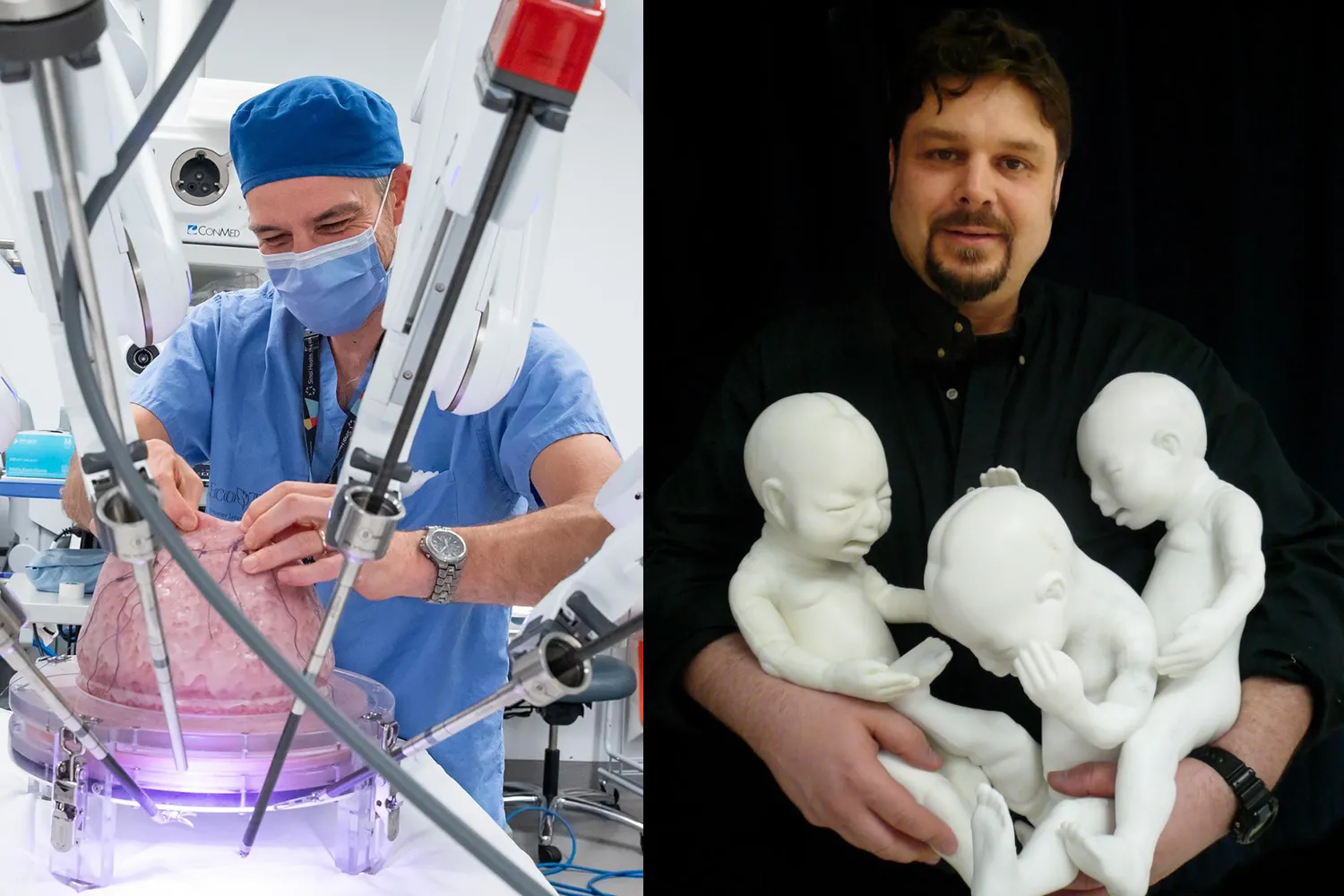When surgeons at the Ontario Fetal Centre (OFC), based at Mount Sinai Hospital, were piloting a state-of-the-art robot to simulate a high-risk operation, they needed to use accurate and responsive medical models for practice and training purposes.
That is when they turned to Associate Professor Francis LeBouthillier (pictured above, right), who is a leader in the development of medical simulation models. He joined the team of surgeons to make this happen and it was no easy task.
In a breakthrough approach currently being researched at OFC, surgical teams use the state-of-the-art, four-armed “da Vinci robot” to perform fetal surgery aimed at repairing spina bifida – a birth defect that affects the spinal cord and can lead to significant disability.
The surgical team required the development of a highly detailed silicone uterus and a fetus with spina bifida. Among the many requirements: it had to be waterproof and be able to hold liquid, as well as gas. Plus, the uterine wall had to be resilient enough to withstand puncturing and resealing, providing a complete real-life environment for the surgeons.
The two-year design process involved countless consultations with a diverse team of experts, including engineers specializing in mathematical modeling. Referring to MRI and CT scans for precise measurements, LeBouthillier was able to re-create the gestational size that the surgeons required.
“I invented a method of manufacturing for this model to provide surgeons with accurate visual and tactile information,” said LeBouthillier. “This allowed them to practice the necessary procedures in utero before performing them on real patients, therefore minimizing the risk of harming the mother and the baby.”
The team, led by Dr. Tim Van Mieghem (pictured above, left), maternal fetal medicine specialist at Mount Sinai Hospital, received funding from the Canada Foundation for Innovation to conduct research to find ways of transforming the way this fetal surgery is performed.
“Surgeons must perfect their technique before attempting high-risk procedures on fetuses in the womb and on newborns,” said Dr. Van Mieghem. “Training on life-like models is critical and the surgical models developed by Francis LeBouthillier are invaluable, enabling us to evaluate and perfect the most optimal approach to the procedure.”
The Ontario Fetal Centre, a partnership between Mount Sinai Hospital and The Hospital for Sick Children (SickKids), is the first in Canada, and one of only a few centres worldwide, to offer a fully comprehensive range of fetal therapy.
Highly skilled in the development and manufacturing of surgical simulators, LeBouthillier obtained his AOCA diploma from the Ontario College of Art (now OCAD U) and obtained a Master of Fine Arts at York University, further honing his skills in the field of sculpture, performance and installation arts. For more than 20 years, LeBouthillier has collaborated with numerous international surgeons to develop innovative surgical training simulators that are currently being used in hospitals around the world.
“To do things that have never been made before, that’s what artists do,” adds LeBouthillier. “I’m honoured to be working with this brilliant group of surgeons who save and improve patients’ lives.”
Incorporating art and design in the medical field is not new to OCAD University. Currently, nine University of Toronto surgeons are participating in the Fostering Your Creativity program, offered by OCAD U’s School of Continuing Studies.
The initiative, supported and funded by the Department of Surgery at the University of Toronto, aims at deepening surgeons’ understanding of how creativity can inspire innovative solutions to the human-centred challenges they face each day.
Photo caption (left): Dr. Tim Van Mieghem with silicone uterus and da Vinci Robot (courtesy Sinai Health)
Photo caption (right): Professor Francis LeBouthillier with fetus models

